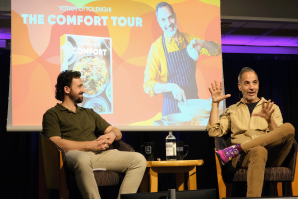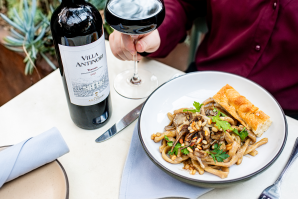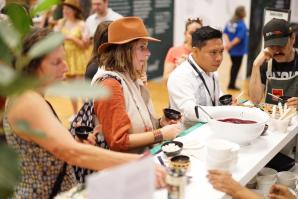“Imagine a piece of bread,” says Elizabeth McQueen, a postdoctoral fellow at UC Davis working on the Mellon Foundation-funded initiative “Thinking Food.” She is kicking off the joint book launch and flour milling demonstration led by baker-poet Jim Franks and UC Davis’ Student Collaborative Organic Plant Breeding Education, or SCOPE, with Margaret Atwood’s prose poem “Bread.” The poem, like the event, is an invitation to use the humble food as a starting point to consider different worlds and perspectives.
As the attendees of the Feb. 11. launch introduce ourselves around the picnic tables, they discover that bread evokes everything from comfort and full bellies, moreish brioche and marmalade; to the ironic “breadless bread” plate from the 2022 film “The Menu,” a dark satire set in an exclusive restaurant where bread’s absence was directly linked to their (spoiler) fatal demise. Indeed, lack of bread, as in Atwood’s poem, is a common synecdoche for famine.
After reading Franks’ new book, “Existential Bread,” McQueen envisioned the workshop as a bridge between the makers and the bakers. “Food is not just diet, nor can health be simply defined. Artists, whether poets, filmmakers, chefs, sculptors, performance artists, et cetera, offer myriad approaches to how we think about food,” says McQueen. Her participation led to the workshop being the first stop on Franks’ cross-country book tour, which includes stops in San Francisco, Portland and New York.
Baker and poet Jim Franks works the dough.

To facilitate the workshop, she partnered with SCOPE, a student-led initiative at UC Davis that partners with faculty, staff and organic growers to develop crop varieties suited for organic farming in California. Through traditional, field-based breeding methods, SCOPE focuses on crops like tomatoes, wheat, spinach, celtuce and zinnias, conducting trials at the UC Davis Student Farm and other locations to address regional growing conditions. This kind of interdisciplinary, collective approach offers a new way to consider our relationship with food and the complex processes and economics behind it.
Imagine “real” bread
One volunteer at the workshop, Sara de Blas Hernandez (Ph.D. candidate in Spanish and Portuguese), shares her own relationship with bread: “Can I trust it?” While she can appreciate bread’s universal associations with community and nourishment, she must relegate it to her imagination.
“I decided to participate in the bread workshop despite having celiac disease because I am a strong advocate for — and love — hands-on activities,” she says. “My whole Ph.D. revolves around re-connecting students with their senses by making and tasting food from the literary texts covered in class using really old and cool recipe books. There is a good bit of cooking involved in the classes that I teach or help teach.”
SCOPE coordinator Laura Roser and post doctoral fellow Elizabeth
McQueen demonstrate a flour mill at the UC Davis Student Farm.
(Photos by Anna Dobrowolski)

She attended the event not only as an ambassador for the “Thinking Food” initiative, which she’s been involved with since its launch, but also out of curiosity about the bread-making process. “One of my goals was to get some info on gluten-free sourdough bread. I’ve wanted to bake my own bread for the longest time and was looking for motivation and encouragement from the workshop and from Jim (Franks),” she says.
Franks provided motivation, but not necessarily the recipe. “Don’t believe anyone who tells you they have the only recipe you’ll ever need. Myself included,” he says. The definition of bread is subject to market trends, opinion and the consumer’s imagination.
For Franks, the word “real” motivated his journey into bread baking. He started baking in Chicago before traveling nationally and internationally, training with bakers and learning the tricks (and hoaxes) of the trade.
So when a publisher asked him to write a cookbook, he chose poetry instead:
Why Cookbooks and Bread Don’t Mix
This book isn’t about
how to make bread
because there isn’t
just one way.
He wanted to demystify the baking process by blending research and non-recipes in blank verse. The result: an unapologetic homage to bread without waxing sentimental. “I’m not one of those bakers who thinks everybody should be eating more bread. In fact, I think people eat too much bread — but not the good kind.” Bread today is a luxury item, and “artisanal” methods reflect the increasing cost of resources — everything from the price of seed to wheat to water.
Bread is made with two main ingredients: flour and water.

Dropping wheat and beats: SCOPE’s work in plant breeding
“When I first started baking, people would say that I’d be so prepared for the apocalypse. Do they know how much work it takes to harvest and mill this flour? This,” he says as he points to the mills, “is such a luxury.”
The book launch attendees didn’t have to grow or harvest their own wheatberries, but they did learn to mill them into flour. Laura Roser, one of SCOPE’s facilitators, guided them through the two small stone mills her students use to practice making their wheat. SCOPE students practice milling what they sow and are encouraged to take home the flour for test bakes.
“Our program is focused on breeding cultivars for the artisanal milling and baking community, which Jim is a part of,” says Roser. “Collaboration and public outreach is also an important part of our program, and we love hosting events that bring together folks from different disciplines together in creative ways.”
At UC Davis, SCOPE’s student plant breeders are cultivating flour varieties. UC Amarillo is a hard, white wheat variety with yellow pigment that was released in 2019 from the wheat breeding program. “The Small Grains team is also about to release blue and charcoal wheats, which we are now using,” Roser shares. Both blue and charcoal varieties have (as their name suggests) indigo tints, caused by incorporating high anthocyanin and lutein traits (commonly found in blueberries and pomegranates) into wheat populations. These high antioxidant varieties are intended for whole wheat baking. She reports that they are also tasty in pancake form. Franks heard of these wheat varieties at the California Wheat Commission and was eager to see them in person.
When the seeds are still in the endosperm (hard seed) stage, they can be chewed on by bakers to determine the quality of the final flour. They can even be puffed up and toasted, like freekeh. This process is also commonly seen in farro or buckwheat production, Franks explains. Softer wheat varieties are often used for pastries. Once milled, he demonstrates how freshly milled flour can either clump together or fall apart like sand or grits. “Milling brings the enzymes to life,” Franks remarks as attendees feed the seeds into the mills.
But Franks notes the high waste culture surrounding mills and their need to mitigate the market demands — a reality that cannot be avoided. “Bakers want high-protein, low-gluten flour for a variety of individualized reasons — which makes it impossible to have one set recipe or one ‘right’ way to approach bread.”
He says later, “I think a lot about the idea of real bread and whether one bread can really be better than another, or how do we even define reality when it is so subjective. I have some pretty strong opinions about bread and how it should be done, but I’m always trying to slay the dragon of ‘should.’”
The workshop ends the way it began, with poetry. Attendees leave with bags of freshly milled flour, sourdough starter and scraps of paper. McQueen prompts them to scribble thoughts that push beyond the recipe and into some form of poetry.
“To think interdisciplinarily, as many universities call for, means bringing together research projects on campus that may seem disparate: plant breeding and literary studies, for example,” McQueen says. “In some ways, these collaborations are experiments: I wasn’t sure what would happen to have plant science students and English students. But unsurprisingly, we have more in common than not, and it led to a slow and thoughtful practice with wheat, flour and the possibility of bread.”
–
Stay up to date on business in the Capital Region: Subscribe to the Comstock’s newsletter today.
Recommended For You

‘Comfort’ Comes to the Capital
Celebrity chef Yotam Ottolenghi visits the Sacramento Public Library
On Friday, October 11, Yotam Ottolenghi hosted a book talk and cooking demo at Sacramento’s Tsakopoulos Library Galleria. Some were surprised that such a big name in the culinary world would visit “Sacramento, of all places” — despite the agricultural epicenter Comstock’s readers know Sac to be.

Chefs, Growers and Citizen Scientists Are Embracing Mushroom Foraging and Its Culinary Potential
The farm-to-fork pipeline is well established in Sacramento — but what about forage-to-fork? We talked to some of the foragers, scientists, chefs and enthusiasts who want to see more foraging in the Capital Region.

Vino Madre
Juicy scenes from the wine tasting room at the first Terra Madre Americas
For three days in May, the floor of the Memorial Auditorium was transformed into a global foodways classroom where one could sample coffee from Honduras, eat a cookie made from Bolivian quinoa and spin an oversized wheel that directed you to pithy sayings by food journalist Michael Pollan.

From Farm to Glass
They’re just miles apart, but Capital Region wine regions are distinctively different based on their climate, terrain and soil
Each of our four wine regions has its own unique terroir, a French term describing the soil, climate and sunshine that give wines their distinct character. These winemakers want consumers to consider their wines farm-to-fork — that is, farm-to-glass.



